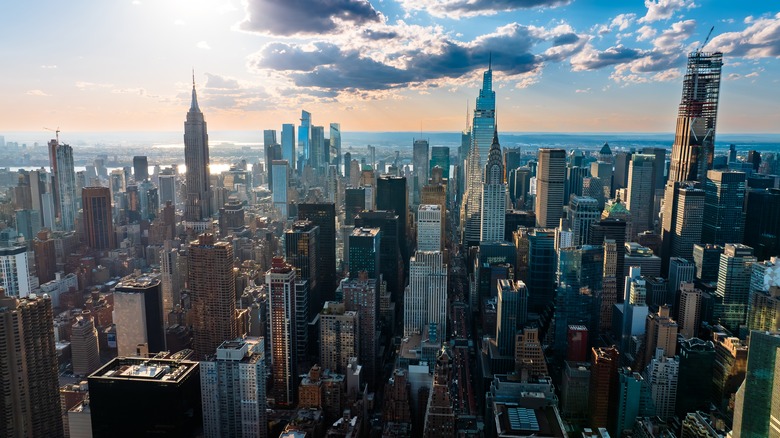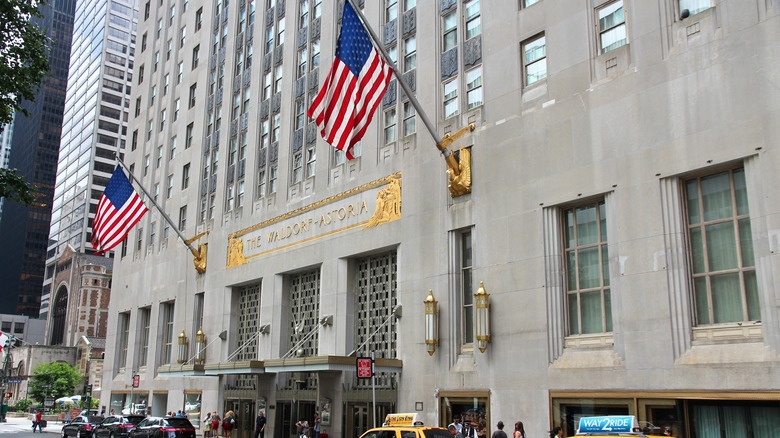The World's First Skyscraper Hotel Has Reopened As A Renovated Art Deco Marvel In New York City's Heart
Among its many marvels, New York City is known for its skyscrapers. The Empire State Building, considered the happiest tourist attraction in all of America, is arguably the most recognizable feature in the city's skyline. Besides its beloved skating rink, Rockefeller Center also boasts a heart-pounding revolving platform with the city's most expansive views. Now, rejoining their ranks in the heart of the city as another iconic skyscraper open to the public, there's the Art Deco marvel that is the Waldorf Astoria. The world's first skyscraper hotel — standing tall at 47 stories — the building officially reopened as of July 15 after a long hiatus.
Formerly two separate neighboring hotels, the Waldorf and the Astoria actually moved from their original location in 1929 to accommodate the development of the Empire State Building. The Waldorf Astoria as we now know it today reopened in 1931 during the height of the Art Deco movement in the U.S. — with a limestone facade outfitted with bronze and copper fittings, not to mention its intricate, elaborate interior. It has seen several ownership changes over the years, and myriad renovation projects. It last housed guests in 2017 and, in the intervening years since, it has been meticulously restored to reflect its grand, Art Deco heritage.
The Waldorf Astoria is located on Park Avenue between 49th and 50th streets in Manhattan, just a few blocks from Grand Central Terminal. As author and historian David Freeland recently told The New York Times, "I'd like to think that the reopening [of the Waldorf Astoria] symbolizes the return of a great public space within the life of the city." In that spirit, here's everything you need to know about one of 2025's most anticipated hotel openings across the globe.
How to experience the newly renovated Waldorf Astoria
The good news is that you don't have to book a room to take in the newly renovated masterpiece. In addition to preserving the iconic exterior of the Waldorf Astoria — designated as a city landmark in 1993 — one of the goals of the recent renovation project was to transport visitors inside the space to the golden, Art Deco age of its original construction.
The lobby itself features numerous design elements and cultural relics worth marveling at — among them, the "Wheel of Life" mosaic embedded in the marble floor, an 1893 clock which required its own meticulous restoration, and American Songbook composer Cole Porter's Steinway grand piano, from when he called the hotel home. Even without looking for any relic in particular, the grandiosity of the space is designed to transport you. Restaurants available in the iconic hotel include the elegant American brasserie Lex Yard, the no-reservations Peacock Alley Bar, and Japanese kaiseki-inspired Yoshoku.
Rooms are fewer and more expensive than they were when the Waldorf Astoria was last available to guests, but also more spacious and luxurious. In 2017, the hotel offered 1,400 rooms. After the current renovation, the iconic landmark has been transformed into both a place to visit and a place to live, with 372 residential spaces and 375 boutique hotel rooms. The rate for the expansive and well-appointed rooms starts at $1,500 a night. For curious travelers who can't resist the luxury and history on offer at the Waldorf Astoria, bookings are available via the hotel's website.

